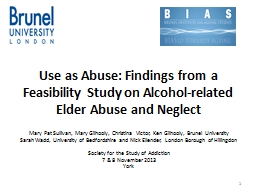

Mary Pat Sullivan Mary Gilhooly Christina Victor Ken Gilhooly Brunel University Sarah Wadd University of Bedfordshire and Nick Ellender London Borough of Hillingdon Society for the Study of Addiction ID: 1032292
Download Presentation The PPT/PDF document "Use as Abuse: Findings from a Feasibilit..." is the property of its rightful owner. Permission is granted to download and print the materials on this web site for personal, non-commercial use only, and to display it on your personal computer provided you do not modify the materials and that you retain all copyright notices contained in the materials. By downloading content from our website, you accept the terms of this agreement.
1. Use as Abuse: Findings from a Feasibility Study on Alcohol-related Elder Abuse and NeglectMary Pat Sullivan, Mary Gilhooly, Christina Victor, Ken Gilhooly, Brunel UniversitySarah Wadd, University of Bedfordshire and Nick Ellender, London Borough of HillingdonSociety for the Study of Addiction7 & 8 November 2013York1
2. Elder abuseA single or repeated act or lack of appropriate action, occurring within any relationshipwhere there is an expectation of trust, which causes harm or distress to an older person (WHO).No Secrets (2000) Ideological underpinnings: empowerment, protect those in greatest need (i.e. those without mental capacity)Elder abuse prevalence rate (UK) (2008) 2.6 – 4 % community dwelling older people 2
3. Elder abuseWorld Environmental Scan (2010)Global problemSocial isolation largest risk factor in developed nationsOlder people’s social presentationCapacity versus capabilityLittle understanding of self neglectAbsence of theoretical development, including models of detection and intervention3
4. Alcohol and Elder AbuseIrish national profile of elder abuse cases (n-1189) - 8% of victims and 31% of perpetrators had alcohol issue (3% & 21% drugs)(US) 5,777 random sample of older people (1/10 reported elder abuse incidents)4%Female PerpetratorsMale PerpetratorsPsychological abuse28.922Physical abuse53.865.9Sexual abuse21.726.5
5. Alcohol and Elder AbuseUndisputed ‘overlap’ between alcohol and domestic violenceAlcohol dependent family members may be financially dependent and more prone to physical aggressionCarers may encourage older people to drink to exploit themSevere physical abuse, both the perpetrator and older person were found to abuse alcoholSelf-neglectAlcohol treatment alone does not necessarily remove the risk for abusePractitioners not adequately trained5
6. Study AimsTo collect substantive pilot data to:Scope the nature and extent of alcohol-related elder abuse and neglectEvaluate data sources and research methods for consideration of a national study on the role of alcohol in elder abuse cases6
7. MethodsComprehensive review of the literature, including an evaluation of existing data setsAnalysis of referrals to one Safeguarding Adults Team (2010/2011) for people ≥ 60 years of age (n=1197) Interviews with a purposive sample of practitioners (safeguarding and speciality alcohol programmes) using critical incident technique (n=12) 7
8. SA Referrals (n=907) Victim PerpetratorFemale 66% 21%Age (mean) 80.6 yrs (60-101) 63.8 yrs Alc. Use 5% 39%W British 96% -8
9. Type of elder abuse/victim’s alcohol use(e.g. 53% of alc use victims suffer financial abuse versus 26% of non alc use )9
10. Victim Characteristics10 Alcohol Use Victims Other Victims (n=41, 5%) (n=866, 95%) Mean Age 72.6 81.4 Male ( % ) 75 25 Financial Abuse ( % ) 53 26 Perp Alc Use ( % ) 66 33 Friend/Neighbour ( % ) 24 6 Prof Carer ( % ) 20 54
11. Victim ProfileMale living alone (60-80 yrs of age)Longstanding heavy alcohol useSocially distant from familyMultiple physical health problems Has ‘capacity’Drinking with friends/neighbours (sometimes local gangs)Sharing bank card, friends buying the alcohol, possessions in home disappearingUnsubstantiated‘Monitoring’ via carers or landlord11
12. Interventions and OutcomesMonitoringFinancial advice/advocacy3+ others involved/liaised with2 where alcohol services were involvedNot recording information on the perpetratorNo intervention with perpetrator12
13. ConclusionsNature of the problem only partially understood by using safeguarding reporting dataVictim’s alcohol use is partially related to financial abuse; other forms of abuse not related to the victim’s alcohol useCharacteristics of victims with alcohol use reported are typically younger, male, being abused by a friend or neighbour who is also using alcoholNature of intervention reflects the limitations of England’s SA policy frameworkLack of understanding of alcohol problems among older people and elder abuse and how to interveneStigma and discrimination (alcohol abuse and elder abuse)13
14. Acknowledgements:Alcohol Research UKGrant: SG/11/12/17214
15. Some ReferencesAmstadter A.B., Cisler J.M., McCauley J.L., Hernandez M.A., Muzzy W. and Acierno R. (2011) Do incident and perpetrator characteristics of elder mistreatment differ by gender of the victim? Results from the national elder mistreatment study. Journal of Elder Abuse & Neglect, 23, 43-57.Biggs S., Manthorpe J., Tinker A., Doyle M., and Erens B. (2009). Mistreatment of older people in the United Kingdom: Findings from the first national prevalence study. Journal of Elder Abuse & Neglect, 21, 1–14. Campbell Reay A.M. and Browne K.D. (2001) Risk factor characteristics in carers who physically abuse or neglect their elder dependents. Aging & Mental Health, 5(1), 56-62. Choi N.G. and Mayer J. (2000) Elder abuse, neglect and exploitation: Risk factors and prevention strategies. Journal of Geronotological Social Work, 33(2), 5-25. Cooper C., Selwood A. and Livingston G. (2008) The prevalence of elder abuse and neglect: A systematic review. Age and Ageing, 37, 151-160. Friedman L.S., Avila S., Tanouye K, and Joseph K. (2011) A case-control study of severe physical abuse of older adults. Journal of American Geriatrics Society, 59, 417-422. Humphreys C., Regan L., River D. and Thiara R.K. (2005) Domestic violence and substance use: tackling complexity. British Journal of Social Work, 35, 1303-1320. Krug E.G., Mercy J.A., Dahlberg L.L. and Zwi A.B. (2002) The world report on violence and health. The Lancet, 360, 1083-88.Podnieks E., Anetzberger G.J., Wilson S.J., Teaster P.B. and Wangmo T. (2010) Worldview Environmental Scan on Elder Abuse. Journal of Elder Abuse & Neglect, 22 (1/2), 164-179. 15